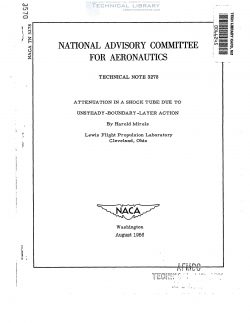naca-tn-3278
- Version
- 109 Downloads
- 2.49 MB File Size
- 1 File Count
- January 23, 2017 Create Date
- January 23, 2017 Last Updated
National Advisory Committee for Aeronautics, Technical Notes - Attenuation in a Shock Tube Due to Unsteady Boundary Layer Action

A method is presented for obtaining the attenuation of a shock wave
in a shock tube due to the unsteady boundary layer along the shock-tube
walls. It is assumed that the boundary layer is thin relative to the
tube diameter and induces one-dimensional longitudinal pressure waves
whose strength is proportional to the vertical velocity at the edge of
the boundary layer. The contributions of the various regions in a shock
tube to shock attenuation are indicated.
The method is shown to be in reasonably good ag’eement with exist—
ing experimental data.
A shock tube consists of a fluid at high pressure (region 4: of fig.
1(a)) separated by a diaphragm from a fluid at low pressure (region 1) .
When the diaphragm bursts, a shock wave propagates into region 1 while
an expansion wave propagates into region 4. A time—distance lot of
these waves under ideal conditions is indicated in figure' 1&3 Regions
2 and 3 have the same velocity and pressure but have different tempera—
tures. The interface between regions 2 and 5 is referred to as a con—
tact surface. The analysis of the flow for perfect fluids is straight-
forward (see, for example, ref. 1). In an actual shock tube, however,
viscosity and heat conduction can not be ignored. These lead to a bound-
ary layer along the walls of the shock tube as indicated in figure 1(a).
The boundary layer introduces nonunifomities into the shock tube.
Analytical studies of this boundary layer are presented in references 2 to
6. One of the important consequences of the wall boundary layer is that
it generates weak pressure waves which catch up with and attenuate the
shock wave propagating into region 1. This attenuation has been studied
emerimentally and analytically in the work of references 1, 4;, 5, and
6, and is the subject of the present report. It is assumed that the
boundary layer is thin relative to the shock-tube diameter. This is a
practical restriction, since most shock tubes are designed so that the
core of potential flow is relatively uniform in order to permit aero-
dynamic tests.
| File | Action |
|---|---|
| naca-tn-3278 Attenuation in a Shock Tube Due to Unsteady Boundary Layer Action.pdf | Download |

Comment On This Post